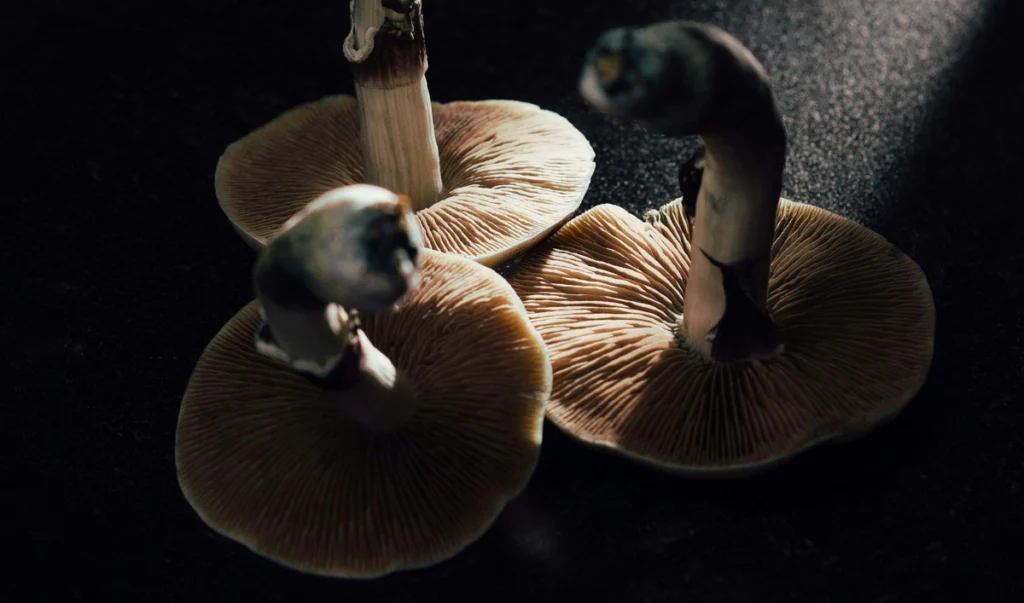What Does Psilocybin Do?

We’re here to unpack psilocybin—the psychoactive compound in so-called “magic mushrooms” that has intrigued scientists, clinicians, and traditional cultures alike for its ability to reshape perception and mood.
In this guide, we’ll explore how psilocybin interacts with the brain, examine its potential benefits and risks, highlight key findings from peer-reviewed research, and describe what the experience typically feels like.
Quick Answer: What Does Psilocybin Do?
In a nutshell, psilocybin converts into psilocin in your brain and agonizes serotonin 5-HT2A receptors, leading to altered connectivity, perceptual changes, and emotional release. In clinical and research settings, it has shown rapid antidepressant and anxiolytic effects, may aid addiction treatment, and ease end-of-life distress. Effects typically last 4–6 hours.
What Is Psilocybin?
Psilocybin is a naturally occurring psychedelic compound (4-phosphoryloxy-N,N-dimethyltryptamine) produced by over 100 mushroom species.
Indigenous peoples in Central America have used these mushrooms in ceremonies for more than 2,000 years. Western scientists first isolated psilocybin in the 1950s, launching modern psychedelic research. Unlike LSD or DMT, psilocybin tends to produce a gentler, shorter experience.
Key facts:
- Chemical structure: 4-PO-DMT
- Natural sources: Psilocybe, Panaeolus, Gymnopilus genera
- Traditional use: Mazatec healing and divination rituals
- Modern research: Clinical trials for depression, anxiety, and addiction
How Psilocybin Works in the Brain
At Rose Neurospa, we’re fascinated by how a single molecule can spark profound shifts in perception and mood. Here’s what happens when you take psilocybin:
- Metabolism & bioavailability: When you ingest psilocybin, enzymes in your digestive tract remove its phosphate group, creating psilocin.
- Serotonin receptor agonism: Psilocin binds to your 5-HT2A receptors in the prefrontal cortex, modulating neuronal firing patterns tied to mood, creativity, and self-perception.
- Brain network dynamics: Functional MRI shows psilocybin dampens activity in your default mode network, boosting global connectivity—this shift often corresponds with ego dissolution or mystical-type experiences.
- Neuroplasticity: Preclinical models suggest psilocin rapidly stimulates dendritic spine growth and synaptogenesis, which may underpin long-term mindset changes.
We’re still unraveling the downstream molecular pathways and why individual factors—genetics, microbiome—shape each unique journey.
Subjective Effects: What It Feels Like
- Perceptual shifts: visual trails, enhanced colors, and synesthesia.
- Time distortion: you may look at the clock after what felt like an hour only to find it has been 10 minutes or so.
- Emotional amplification: euphoria, awe, connectedness, or tearfulness.
- Mystical-type states: “oceanic boundlessness” and unity with surroundings.
- Challenging moments: anxiety, confusion, or paranoia spikes—often dose- and mindset-dependent.
Intensity scales (Note that dosage is different for everyone and best handled by a professional):
- Low dose (0.5–1 g dried): mild euphoria, visual enhancement
- Moderate (1–2.5 g): strong visuals, introspection
- High (>2.5 g): possible ego dissolution
Typical timeline: onset 20–60 min; peak 2–3 hrs; duration 4–6 hrs; afterglow days-long uplift
Risks & Safety Considerations
At Rose Neurospa, we take safety seriously. While psilocybin’s physiological toxicity is low, you should be aware of several risks:
- Physical effects: transient increases in heart rate and blood pressure—avoid if you have cardiovascular issues.
- Psychological risks: anxiety, paranoia, or outright panic—especially if you have a personal or family history of psychosis.
- Toxicity: lethal dose is extremely high, but misidentifying wild mushrooms can be deadly.
- Drug interactions: SSRIs may blunt psilocybin’s effects; MAOIs can amplify and prolong experiences.
- Professional supervision: a trained facilitator can help you navigate challenging moments and ensure a safe environment.
Final Thoughts on Psilocybin’s Effects
We’ve covered psilocybin’s mechanisms, effects, benefits, and safety considerations. Always consult healthcare professionals before considering psilocybin. For more information, explore:
- National Institute on Drug Abuse (NIDA)
- Multidisciplinary Association for Psychedelic Studies (MAPS)
- Peer-reviewed journals like Journal of Psychopharmacology
- Local legal resources for current regulations
Rose Neurospa is Colorado-based collective of licensed clinical facilitators devoted to offering psilocybin-assisted therapy in a compassionate and meaningful practice. If you’re in Colorado, and interested in psychedelic therapy, make sure to give us a call!